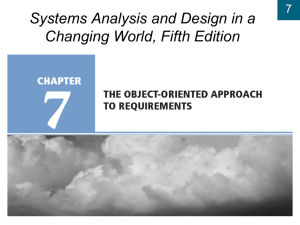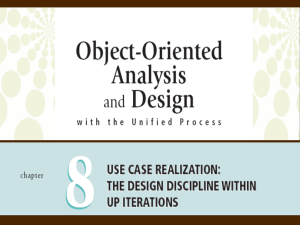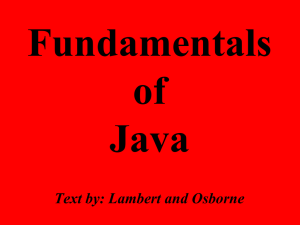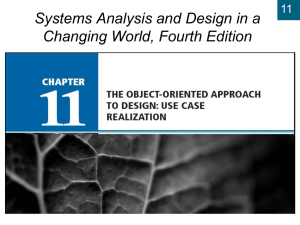Introduction to Computer Science
advertisement
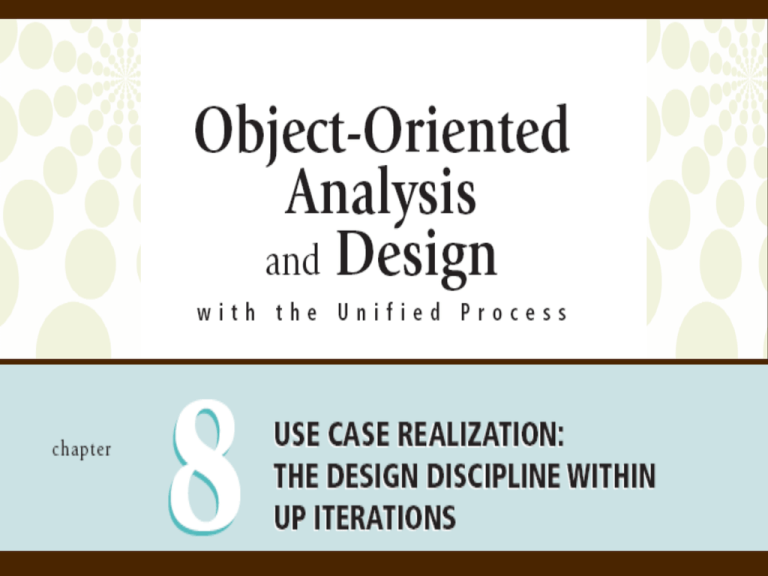
Objectives Explain the purpose and objectives of objectoriented design Develop design class diagrams Develop interaction diagrams based on the principles of object responsibility and use case controllers Object-Oriented Analysis and Design and the Unified Process 2 Objectives (continued) Develop detailed sequence diagrams as the core process in systems design Develop communication diagrams as part of systems design Document the architecture design using package diagrams Object-Oriented Analysis and Design and the Unified Process 3 Overview Develop detailed object-oriented design models Develop models for each layer of a three-layer design Design class diagrams Extend domain model Interaction diagrams Extend system sequence diagrams Package diagrams Show relationships and dependencies among classes Object-Oriented Analysis and Design and the Unified Process 4 What is Object-Oriented Design? The bridge between a user’s requirements and programming for the new system “Blueprints”, or design models, are necessary to build systems An adaptive approach to development Requirements and design are done incrementally within an iteration A complete set of designs may not be developed at one time Object-Oriented Analysis and Design and the Unified Process 5 Overview of Object-Oriented Programs Object-oriented programs consist of a set of computing objects that cooperate to accomplish a result Each object has program logic and data encapsulated within it Objects send each other messages to collaborate Most object-oriented programs are event-driven Instantiation of a class creates an object based on the template provided by the class definition Object-Oriented Analysis and Design and the Unified Process 6 Figure 8-1 Object-oriented event-driven program flow Object-Oriented Analysis and Design and the Unified Process 7 Object-Oriented Design Models Identify all objects that must work together to carry out a use case Divide objects into groups for a multilayer design Interaction diagrams describe the messages that are sent between objects Includes sequence and communication diagrams Design class diagrams document and describe the programming classes Object-Oriented Analysis and Design and the Unified Process 8 Figure 8-2 Design class for Student class Object-Oriented Analysis and Design and the Unified Process 9 Figure 8-3 Class definition of the Student class in the Java programming language Object-Oriented Analysis and Design and the Unified Process 10 Object-Oriented Design Models (continued) Statecharts capture information about the valid states and transitions of an object Package diagrams denote which classes work together as a subsystem Design information is primarily derived from Domain model class diagrams Interaction diagrams Object-Oriented Analysis and Design and the Unified Process 11 Figure 8-4 Design models with their respective input models Object-Oriented Analysis and Design and the Unified Process 12 Object-Oriented Design Process Create a first-cut model of the design class diagrams Develop interaction diagrams for each use case or scenario Update the design class diagrams Method names, attributes, and navigation visibility Partition the design class diagrams into related functions using package diagrams Object-Oriented Analysis and Design and the Unified Process 13 Design Classes and Design Class Diagrams Design class diagrams are extensions of domain class model diagrams Elaborate on attribute details Define parameters and return values of methods Define the internal logic of methods A first-cut design class diagram is based on the domain model and engineering design principles Interaction diagrams are used to refine a design class diagram as development progresses Object-Oriented Analysis and Design and the Unified Process 14 Design Class Symbols Stereotypes UML notation to categorize a model element as a certain type Two types of notation Full notation with guillemets («») Shorthand notation with circular icons Standard stereotypes Entity, control, boundary, data access Object-Oriented Analysis and Design and the Unified Process 15 Figure 8-5 Standard stereotypes found in design models Object-Oriented Analysis and Design and the Unified Process 16 Design Class Notation Class name and stereotype information Attribute information Visibility, type-expression, name, initial value, and properties Method signature Visibility, name, type-expression, and parameter list Use the entire signature to identify a method to distinguish between overloaded methods Object-Oriented Analysis and Design and the Unified Process 17 Figure 8-6 Internal symbols used to define a design class Object-Oriented Analysis and Design and the Unified Process 18 Figure 8-7 Student class examples for the domain diagram and the design class diagram Object-Oriented Analysis and Design and the Unified Process 19 Some Fundamental Design Principles Encapsulation Each object is a self-contained unit containing both data and program logic Object reuse Standard objects can be used over and over again within a system Information hiding Data associated with an object is not visible Methods provide access to data Object-Oriented Analysis and Design and the Unified Process 20 Some Fundamental Design Principles (continued) Navigation visibility Describes which objects can interact with each other Coupling Measures how closely classes are linked Cohesion Measures the consistency of functions in a class Separation of responsibilities Divides a class into several highly cohesive classes Object-Oriented Analysis and Design and the Unified Process 21 Figure 8-8 Navigation visibility between Customer and Order - coupling Object-Oriented Analysis and Design and the Unified Process 22 Developing the First-Cut Design Class Diagram Elaborate the attributes with type and initial value information Most attributes should be private Add navigation visibility arrows Based on which classes need access to which other classes Can be bidirectional Will need to be updated as design progresses Object-Oriented Analysis and Design and the Unified Process 23 Figure 8-10 First-cut RMO design class diagram Object-Oriented Analysis and Design and the Unified Process 24 Interaction Diagrams–Realizing Use Cases and Defining Methods Interaction diagrams are at the heart of objectoriented design Realization of a use case Determine what objects collaborate by sending messages to each other Two types Sequence Communication Object-Oriented Analysis and Design and the Unified Process 25 Object Responsibility Objects are responsible for carrying out system processing Two major areas of responsibility Knowing ◘ Knowledge about its own data and about other classes with which it must collaborate to carry out use cases Doing ◘ All the activities an object does to assist in the execution of a use case Object-Oriented Analysis and Design and the Unified Process 26 Figure 8-11 Partial design class diagram for the Look up item availability use case Object-Oriented Analysis and Design and the Unified Process 27 Use Case Controller An artifact invented by the designer to handle a system function Serves as a collection point for incoming messages Intermediary between the outside world and the internal system A single use case controller results in low cohesion Several use case controllers raise coupling but result in high cohesion Object-Oriented Analysis and Design and the Unified Process 28 Designing with Sequence Diagrams An SSD captures the interactions between the system and the external world represented by actors The system is treated like a black box A detailed sequence diagram uses all of the same elements as an SSD The :System object is replaced by all of the internal objects and messages within the system Object-Oriented Analysis and Design and the Unified Process 29 Figure 8-12 SSD for the Look up item availability use case Object-Oriented Analysis and Design and the Unified Process 30 First-Cut Sequence Diagram Determine which other objects may need to be involved to carry out the use case Replace the :System object with a use case controller object Determine which other messages will be sent Define the source and destination object for each message Use activation lifelines to indicate when an object is executing a method Object-Oriented Analysis and Design and the Unified Process 31 Figure 8-14 First-cut sequence diagram for the Look up item availability use case Object-Oriented Analysis and Design and the Unified Process 32 Guidelines for Preliminary Sequence Diagram Development Determine all of the internal messages that result from each input message Define origin and destination objects Identify the complete set of classes that will be affected by each message Flesh out the components for each message Iteration, true/false conditions, return values, and passed parameters Object-Oriented Analysis and Design and the Unified Process 33 Developing a Multilayer Design View layer Design the user interface for each use case Develop dialog designs for forms Add the window classes to the sequence diagram Data access layer Initialize domain objects with data from the database Query the database and send a reference object Return information in the reference object Object-Oriented Analysis and Design and the Unified Process 34 Figure 8-17 Completed three-layer design for Look up item availability Object-Oriented Analysis and Design and the Unified Process 35 A First-Cut Sequence Diagram for an RMO Telephone Order Define a user controller object Define a “create” message for new Order objects Customer object creates the Order object Define other messages addItem, createOrdItem, getDescription, getPrice, updateQty Identify source, destination, and navigation visibility for each message Object-Oriented Analysis and Design and the Unified Process 36 Figure 8-18 SSD for the telephone order scenario of the Create new order use case Object-Oriented Analysis and Design and the Unified Process 37 Figure 8-21 Sequence diagram for the telephone order scenario of the Create new order use case Object-Oriented Analysis and Design and the Unified Process 38 Developing a Multilayer Design for the Telephone Order Scenario Extend one message at a time View layer Open Order window and return a Customer object Data layer Customer object initializes itself Add items to an order with a repeating message Save Order and OrderItem to the database Update database inventory Complete transaction Object-Oriented Analysis and Design and the Unified Process 39 Figure 8-22 Telephone order sequence diagram for the startOrder message Object-Oriented Analysis and Design and the Unified Process 40 Figure 8-23 Telephone order sequence diagram for the addItem message Object-Oriented Analysis and Design and the Unified Process 41 Figure 8-24 Telephone order sequence diagram for the final messages Object-Oriented Analysis and Design and the Unified Process 42 Designing with Communication Diagrams Shows a view of the use case that emphasizes coupling Uses the same symbols as a sequence diagram for actors, objects, and messages Lifeline symbols are not used Link symbols indicate that two items share a message Numbers indicate the sequence in which messages are sent Object-Oriented Analysis and Design and the Unified Process 43 Figure 8-25 The symbols of a communication diagram Object-Oriented Analysis and Design and the Unified Process 44 Figure 8-27 A communication diagram for Create new order Object-Oriented Analysis and Design and the Unified Process 45 Updating the Design Class Diagram Add classes for the view and data access layers Update classes with method signatures Constructor and get and set methods are optional Use case specific methods are required Every message in a sequence diagram requires a method in the destination object Include the new user controller classes and add navigation arrows Object-Oriented Analysis and Design and the Unified Process 46 Figure 8-30 Updated design class diagram for the domain layer Object-Oriented Analysis and Design and the Unified Process 47 Package Diagrams-Structuring the Major Components Associates classes of related groups One option is to separate the view, domain, and data access layers into separate packages Indicate dependency relationships Shows which elements affect other elements in a system May exist between packages, or between classes within packages Packages can be nested Object-Oriented Analysis and Design and the Unified Process 48 Figure 8-31 Partial design for a three-layer package diagram for RMO Object-Oriented Analysis and Design and the Unified Process 49 Implementation Issues for ThreeLayer Design IDE tools can help programmers construct systems IDE tools can also make a system difficult to maintain Programmers put ALL their code in the view layer ◘ Creates window classes that generate class definitions ◘ Inserts business logic code into the user interface Use good design principles when developing a system Define object responsibility for each layer Object-Oriented Analysis and Design and the Unified Process 50 Object Responsibilities View Layer Display electronic forms and reports Capture input (events) Displays data fields Accept input data Edit and validate input data Forward input data to the domain layer classes Startup and shutdown the system Object-Oriented Analysis and Design and the Unified Process 51 Object Responsibilities (cont’d) Domain Layer Create domain (persistent) classes Process all business rules Prepare persistent classes for storage to the DB Data Access Layer Establish and maintain DB connection Contain all SQL statements Process result sets into appropriate domain classes Disconnect gracefully from the DB Object-Oriented Analysis and Design and the Unified Process 52 Summary Design is driven by use cases Two primary models developed during design Design class diagrams Sequence class diagrams Multilayer designs partition classes into groups View, domain, and data access layers Communication diagrams are a viable alternative to sequence diagrams Object-Oriented Analysis and Design and the Unified Process 53 Summary (continued) Object-oriented design principles Encapsulation Coupling Cohesion Navigation Object responsibility Package diagrams can group classes by subsystem or layer Object-Oriented Analysis and Design and the Unified Process 54


